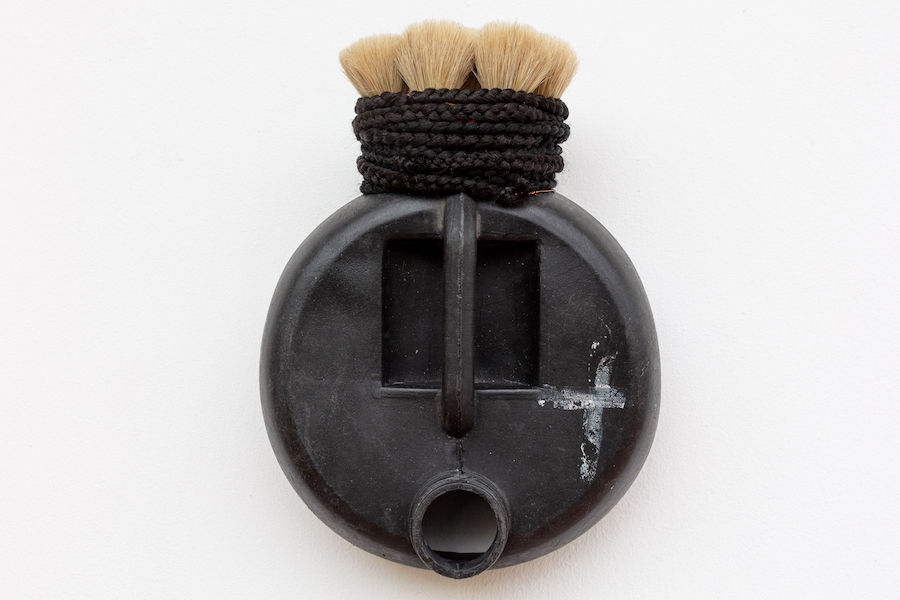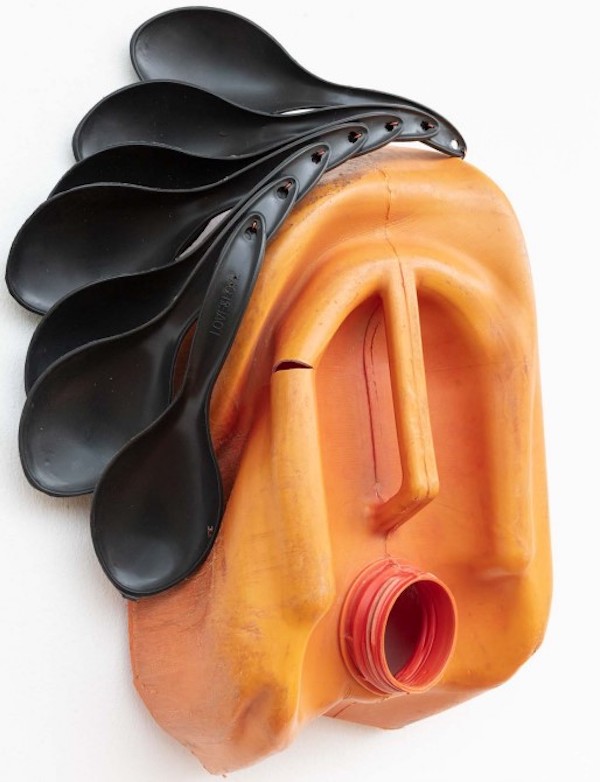Beninese artist Romuald Hazoumè has been making his well-known masks for many years, but ‘Carnaval’, his show at the October Gallery, is unusual in bringing together a large number in conversation with each other.
The masks, combining Yoruba traditions with salvaged contemporary materials, always consist of three elements: a jerry can, one other item, and an activating title. It might be tempting to see them simply as wittily unexpected conjunctions – in, perhaps, a surrealist manner – but that would be to overlook two things. First, the fact that they are always portraits, either of individuals or ‘types’; and second, the particular local significance of the jerry cans. Since gas is far more expensive in Benin than in neighbouring oil-producing Nigeria, organised gangs use the cans to transport contraband gas by moped – so the containers represent a profitable but dangerous activity, as well as connecting more broadly with the highly charged topic of the oil industry. Hazoumè spoke to me from his studio in Porto Novo.
When and how did you make your first mask with a jerry can?
My first mask was made in the 80s. But even before this period, I made masks with everything that came to hand for a children’s game called KALETA (mask). This led to making further pieces that came to the attention of the art world.

What has kept you going with the masks for so long?
I continue to make ‘Masks’ for my community. It’s my duty because there is a quality and a strength that a mask exudes. But that doesn’t mean I can do it all the time; it has become increasingly difficult for me to create masks unless I’m in my workshop. And the work takes a lot of time for the result that you finally see.
How do you see the particular significance of the jerry can as the consistent basis for the mask?
The jerry can is a metaphor for an individual left on the ground. It’s not that the individual is important to me, but rather their story, which can be read through the traces left on the plastic container.
October gallery summarises this particular installation of masks as ‘a whimsical form of contemporary African portraiture’ which ‘in typically ironic fashion…addresses the material exploitation of the African continent throughout colonial history whilst at the same time paying homage to the breadth, originality and independence of Africa’s cultural traditions and values.’ Can you expand on that?
We Africans are still not conscious of exactly what it means to be African. There’s so much ignorance and misunderstanding, and we have no idea about what we could be or even what we should be. What we most need to talk about today is how did we get into this state? More importantly, how do we get out of this state? What retrograde forces prevent progress, and who are the obstacles? That’s what all these masks are discussing between themselves, giving voice to these necessary questions. Certain masks represent the smooth-talking heads of state and politicians, those who give long speeches and have ready-made answers for every problem. Some masks represent the other side of the coin, the people who have no say at all but whose opinions are equally valid. This plurality of peoples and diversity of opinions is the masquerade: a multitude of different voices talking about youth, age, pain or greed; speaking of unimaginable wealth and grinding poverty, of unconscionable excess and unfathomable sorrow. From this torrent of sound emerges the sonorous voice of the ancestors; out of the confused hubbub comes the voice of the people, resonating with the ring of truth. This is Africa; and this is our carnival!

Romuald Hazoumè Blaireau, 2022 – Found objects, 34.5 x 26.5 x 10 cm
Can you say something about some of the specific masks? What lies behind ‘Blaireau’?
It’s a symbol of a type of president that exists in Africa and all over the world. When you call someone ‘Blaireau!’ it’s deeply insulting because you’re implying he’s a blithering idiot. The word has also come to mean a ‘shaving brush’, formerly made using badger hair. So, this is my portrait of one leader, an African badger whose hairstyle I’ve represented using shaving brushes. His type have no idea what they’re supposed to do to lead their countries forward. But badgers can be very long-lived animals. They survive by keeping in lockstep with the ‘great powers’—America, Russia, China and Europe. Not only does he create mayhem all around him, his standard response is to call on God, thinking that’s going to save him. That’s why I selected this particular container, which already had a white cross on the black ground. He’s just ridiculous, a real joke!
What about ‘Pintade’?
Politicians have nicknames given by the people they govern. ‘Pintade’ is a ‘guinea hen’, one of Africa’s oldest birds. They have the same political personality, but you have to search for them. But there is one thing they cannot hide – their true face, which they end up revealing.

And ‘Le Sapeur’?
Today, everyone knows how the urban subculture of people dressing as dandies (‘sapeurs’) flourishes despite the unrelenting poverty. Poor people scrape together complete outfits that take years to assemble and parade in the streets wearing their regalia, striking elegant poses and performing dramatic routines. It’s pure masquerade! If you visit their homes, the reality is they have nothing to eat. These countries, blessed with immense oil and mineral wealth, should be amongst the leading economies on the continent, but they’re controlled by incompetents, so they are instead plagued by poverty, disease and violently divisive conflicts. When you look at their leader’s fine clothes—the Yves St. Laurent suit, the expensive Rolex, the Italian leather shoes—you see the illusion of sophisticated refinement. However, these are not men of vision or political acumen, they are merely clothes horses for deluxe western brands, who believe wearing such finery implies superiority. This Sapeur guzzles his way through enormous riches simply to flaunt his baubles, never realising they’re only of value because he imagines they are. The large spoons decorating this mask focus attention on the ‘special accessories’ others don’t have. In Africa, when we say someone eats with a large spoon, we imply they’ve plenty of food to fill their bellies and live comfortably. These fools scoff all their countries’ riches, which, if properly distributed, could easily feed all the people.

Romuald Hazoumè ‘Kpadjè, 2016
The exhibition also includes some striking photographs. What do they show?
They capture the dance of ‘The Egun-gun’, or ‘those who return from the dead’, venerated by a very large community in West Africa, where all religions intersect among the followers. The photos depict ceremonies created in honour of the ancestors.
Why do you wear a kepi, a military hat covered with badges?
This is my own visual recognition sign. When I arrive in a country, those who come to welcome me can easily recognise me by my hat.
I have heard that there are many different languages in Benin. How many do you speak?
Yes! There are exactly 55 different languages and I speak six. I believe that the multitude of languages implies many different cultures, however, there is a common language: and that is the visual language of Art.
Photos Courtesy October Gallery London and the Artist
Romuald Hazoumè solo exhibition ‘Carnaval’ runs to 26 November 2022 at October Gallery, London. Images of works Copyright R. Hazoumè, Courtesy the Artist and October Gallery, London.

